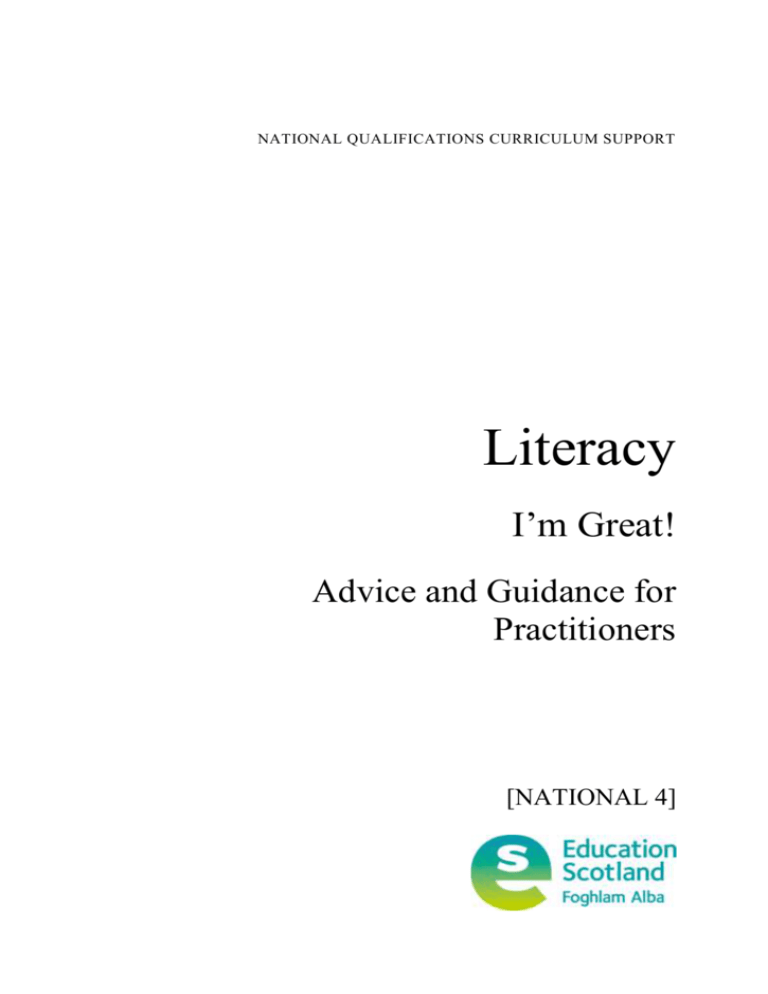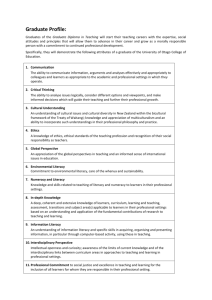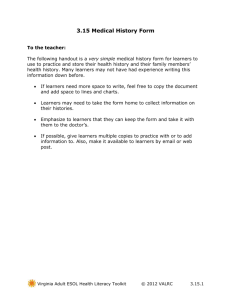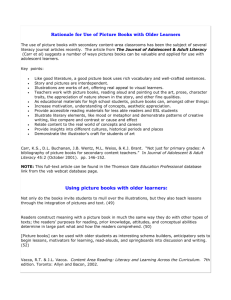Overview of materials
advertisement

NATIONAL QUALIFICATIONS CURRICULUM SUPPORT Literacy I’m Great! Advice and Guidance for Practitioners [NATIONAL 4] This advice and guidance has been produced to support the profession with the delivery of courses which are either new or which have aspects of significant change within the new national qualifications (NQ) framework. The advice and guidance provides suggestions on approaches to learning and teaching. Practitioners are encouraged to draw on the materials for their own part of their continuing professional development in introducing new national qualifications in ways that match the needs of learners. Practitioners should also refer to the course and unit specifications and support notes which have been issued by the Scottish Qualifications Authority. http://www.sqa.org.uk/sqa/34714.html Acknowledgement © Crown copyright 2012. You may re-use this information (excluding logos) free of charge in any format or medium, under the terms of the Open Government Licence. To view this licence, visit http://www.nationalarchives.gov.uk/doc/open-government-licence/ or e-mail: psi@nationalarchives.gsi.gov.uk. Where we have identified any third party copyright information you will need to obtain permission from the copyright holders concerned. Any enquiries regarding this document/publication should be sent to us at enquiries@educationscotland.gov.uk. This document is also available from our website at www.educationscotland.gov.uk. 2 I’M GREAT! (NAT 4, LITERACY) © Crown copyright 2012 Contents Overview of materials Topic 4 4 Section 1: Exemplification of suggested learner activities Activity 1: Labels in learner diary Activity 2: Self-talk Activity 3: Modelling success Activity 4: Mindfulness relaxation 5 5 7 8 10 Section 2: Practitioner guidance Active learning Using ICT to support teaching Activity 1: Labels in learner diary Activity 2: Self-talk Alternatives to PowerPoint Interactive PowerPoint Activity 3: Modelling success Activity 4: Mindfulness relaxation Additional suggestions for activities 12 12 13 15 15 17 18 18 19 20 I’M GREAT! (NAT 4, LITERACY) © Crown copyright 2012 3 OVERVIEW OF MATERIALS Overview of materials The following support materials are intended to guide those preparing learners for reading and writing skills in Literacy at National 4 (6 SCQF credit points). They focus on confidence building and positive mindset, which are key factors in advancing literacy skills successfully, particularly in adults. In addition, although these materials are more relevant to the college sector, practitioners in schools may find some interesting ideas in them to explore and develop. Guidance at this level includes advice for practitioners on approaches to learning and teaching, and exemplification of learner activities. Learners are introduced to the notion that developing confidence is a key resource for their literacy development and the practitioner is invited to use the tools suggested in this material to encourage relaxation, visualisati on and discussion of barriers to confidence as part of this process. This material is drawn from research into neuro-linguistic-processing (NLP) and mindfulness approaches to teaching. Additionally, the support material and activities are themed around this topic to reinforce the ‘confidence message’ and as a potential discussion point and topic for activities and written work. In order to get the most out of these materials, practitioners are advised to refer to Section 3: Practitioner guidance before us ing any of the activities in Section 1. Topic The focal theme for these materials is ‘I’m great!’ Here, the focus is on developing the Curriculum for Excellence key theme of health and wellbeing. In addition, exemplification will be provided of suggeste d learner activities that will focus on developing the Curriculum for Excellence capacity of the learner as a confident individual. 4 I’M GREAT! (NAT 4, LITERACY) © Crown copyright 2012 SECTION 1 Section 1: Exemplification of suggested learner activities Activity 1: Labels in learner diary Use the PowerPoint presentation ‘Labels’. In this task, you will think about the idea of labelling people and about how people’s confidence and motivation change. 1. Which of these labels would help to motivate someone in a workplace situation? 2. Are there any other labels you think could be applied to someone in a workplace or other setting which you think would help to motivate them? I’M GREAT! (NAT 4, LITERACY) © Crown copyright 2012 5 SECTION 1 3. What positive labels have ever been attributed to you? Who gave you these labels? Why? Are there any others you want to add? 4. What labels have others given to your reading and writing skills – if any? What label would you choose to describe your reading and writing skills? 6 I’M GREAT! (NAT 4, LITERACY) © Crown copyright 2012 SECTION 1 Activity 2: Self-talk In this task, you will look at the way you think about yourself and your own abilities. Interior talk eg ‘I’m really bad at spelling.’ ‘No matter what I try, nothing works out the way I want it to.’ Re-framing ‘I’m studying to become a good speller.’ ‘My efforts at things have sometimes paid off and I am learning how to improve.’ I’M GREAT! (NAT 4, LITERACY) © Crown copyright 2012 7 SECTION 1 Activity 3: Modelling success In this activity you will think about how to feel when you start something new. Skillsets: mine and others Own learning Skill learned Examples: Learned English/other language Approach used Learned to drive Listened to instructions and practised techniques many times Learned highway code/driving theory Read theory book and used online tests Learned guitar Watched examples of people playing on YouTube Learned football Watched others play; got advice from good players; Dad told me where I was going wrong; lots of practise Learned computer games Practised and took tips from friends 8 I’M GREAT! (NAT 4, LITERACY) © Crown copyright 2012 Watched English TV and listened to pop lyrics SECTION 1 Skills of other people Skill learned Michael Jordan Approach used Einstein Richard Branson I’M GREAT! (NAT 4, LITERACY) © Crown copyright 2012 9 SECTION 1 Activity 4: Mindfulness relaxation This technique will help you to feel good about learning. Invite learners to sit upright in their chairs with their backs straight against the back of the seat and their feet placed flat on the ground. Their arms should be relaxed and their hands resting palm downwards loosely on their knees. Posture should be upright (slouching causes the sitter to become drowsy) but not stiff or tense. Invite learners to close their eyes if they wish. Close your eyes as you lead the relaxation exercise. ‘Now bring your attention into the room. There ’s nothing we have to do for the next 5/10 minutes except sit and become relaxed and still. We’re just going to let go of all the noise in our heads. Forget all the planning, and all the thinking, and all the anticipating and just be here in this room. Notice that you’ve stopped. It’s very rare to get a moment like this. A moment where it’s quiet and you’ve nothing to do. Just enjoy the sensation of being relaxed. Notice the sounds of the room and let them drift around you at the back of your awareness – not really tuning into them or pushing them away, just noticing that they’re there. Notice the temperature of the room and the feeling of just sitting with your feet flat on the ground. And feel very relaxed. Now bring your attention to your breathing. You don’t have to do anything to your breathing. Just notice the rise and fall of your stomach as you breathe. Notice the sensation of an in-breath as it enters at your nostrils and follow it all the way until you need to breathe out. And then follow the whole of the out-breath until its very end. Just sit and not ice your breathing like this for a few moments. If you find yourself getting distracted by thinking or noises in the room, just go back to your breathing and enjoy the sensation of calming breathing in and out. Now notice any stress that might be there. Bring your attention to the muscles in your face. Imagine the skin of your scalp becoming loose and the tension around your jaw relaxing. Let go of all the tension in your face. 10 I’M GREAT! (NAT 4, LITERACY) © Crown copyright 2012 SECTION 1 Breathe into your neck and shoulders and let all the tension in your shoulder s release so that your shoulders become light and relaxed. Now follow your breath into your heart: notice the speed of your heart beat and see if you can slow it down. Your heart works hard all day responding to your every thought, feeling and action. Now, we’re just going to let it rest. And feel your breath flowing down into your stomach. Emotions often cause us to grip the muscles of our stomach so see if you can release the muscles in your stomach so that you can feel its rise and fall when you breathe. Breathe down through your spine and into your legs and feet, releasing all of your worries, your tiredness out through the soles of your feet. Notice how your breathing has slowed down and become deeper. This is the feeling of your body when it is calm. The ability to become calm and quiet like this is always there – and you can come back to this state whenever you want, just by tuning into your breathing and bringing your attention into your body. Let’s take a minute just to sit and enjoy being quie t and peaceful before we stop the practise. When you’re ready just slowly open your eyes and sit quietly while we come out of sitting. And the end of a short practice like this, it’s useful to ask learners what they felt, if they noticed any changes in breathing, if they felt calmer, etc. If feedback is positive, it can be useful to begin classes with a very short 5 minute breathing exercise on a regular basis. I’M GREAT! (NAT 4, LITERACY) © Crown copyright 2012 11 SECTION 2 Section 2: Practitioner guidance Active learning Does it take longer to teach like this than with traditional practitioner-led lessons? Yes, but: Once learners start thinking independently and working collaboratively this time is made up. Learners have a more secure grasp of concepts – learning is more securely anchored. Learners are more confident about making suggestions, predictions and corrections. It becomes evident to learners and practitioners how learning is progressing so they can work together to make improvements . What improves? Learner confidence, motivation and therefore behaviour (all engaged as all have a contribution to make that is valued). Practitioner enthusiasm. Teaching quality. Quality of learning experience. 12 I’M GREAT! (NAT 4, LITERACY) © Crown copyright 2012 SECTION 2 Using ICT to support teaching This table suggests some ideas for using ICT. The corresponding online tutorials demonstrate how to access/download materials to use in the classroom. Note: You should follow your centre’s e-safety guidelines and protocols regarding the use of YouTube and social networks. Resource name Interactive white board Wiki Smartphone What is it? Tutorial An interactive whiteboard (IWB) is a large interactive display that connects to a computer and projector. Users control the computer using a pen, finger, stylus or other device. Website that anyone can alter Tutorial (10 min): http://www.youtube.co m/watch?v=757UqTy040 A smartphone is a mobile phone built on a mobile computing platform, with advanced computing ability and connectivity Download or start using it Tutorial (2 min): http://www.wikispaces. com/site/tour Uses (10 min): http://www.youtube.co m/watch?v=aXt_de2HBE&feature=relatedd PDA wiki: http://pdaglasgowmet.pbworks .com/ Sign up and create: http://www.wikispaces.com/ A significant number of learners have access to a smartphone I’M GREAT! (NAT 4, LITERACY) © Crown copyright 2012 13 SECTION 2 Flip Toon Doo Xmind Small video camera with integrated USB to charge and transfer video Cartoon strips and books Mind map Tutorial (3 min): http://www.youtube.co m/watch?v=mh6s9gNo Fro Demonstration (1 min) http://www.youtube.co m/watch?v=7aiRzX2L O7Y Demonstration (2 min) http://www.youtube.co m/watch?v=aKYmxOs ddoY 14 I’M GREAT! (NAT 4, LITERACY) © Crown copyright 2012 Information: http://www.theflip.com/engb/products/mino.aspx#/simpl e Sign up and create: www.toondoo.com Download and create: http://www.xmind.net/ SECTION 2 Activity 1: Labels in learner diary Materials Use the PowerPoint ‘labels’, which you can personalise to your own experience. Classroom tables are set up with sticky notes and pens. Task The practitioner can enquire about what labels have been used to describe individuals in the class in the past. The practitioner’s own slide can include positive and negative labels: ‘lazy’, ‘clever’, ‘funny’, ‘boring’ etc. The point here is: 1. 2. 3. to illustrate that we have all received positive labels for some things, eg ‘gifted’ (at playing guitar) but ‘lazy’ (at sports), showing that intelligence is not a fixed entity but made up of a variety of different skill sets to demonstrate that the practitioner has both strengths and weaknesses and therefore that learning progress is made by developing a range of skills to suggest that labels do not say something intrinsic about us, but simply describe different responses to different environments. Learners are invited to use sticky notes to write down some labels that they have been given in the past. Discussion can encourage the notion that labels are not fixed but can be accepted or rejected. Focus can be drawn to positive labels and the kinds of experiences that led to positive feedback. Activity 2: Self-talk Suggested approach PowerPoint presentation ‘Self-talk’ and other self-talk materials. Task Potentially following on from the last activity, learners are introduced to the idea of ‘self-talk’: the way that we speak to ourselves and about ourselves inside our own heads. Invite learners to write down some of the things that I’M GREAT! (NAT 4, LITERACY) © Crown copyright 2012 15 SECTION 2 they habitually say to themselves about their reading, spelling and writing, and about life in general, using the self-talk materials. Using the PowerPoint ‘Self-talk’, the class can be introduced to the basic idea that the way we say things influences how our mind and body responds to them. Following class discussion, learners are invited to reframe their negative self talk into more positive constructions following t he simple examples in the PowerPoint. 16 I’M GREAT! (NAT 4, LITERACY) © Crown copyright 2012 SECTION 2 Alternatives to PowerPoint 1. Prezi Free. Click the arrow to navigate round the Prezi presentation in the demonstration (2 min) at http://prezi.com/hgjm18z36h75/why-shouldyou-move-beyond-slides/ 2. MindMap See video demonstration (5.5 min) at http://www.smartdraw.com/ specials/mindmapping.asp 3. Xmind Free. See video demonstrations at: XMIND Demo Part 1, Basic Operations (2 min) at www.youtube.com/watch?v =7aiRzX2LO7Y XMIND Demo Part 2, Structures (2 min) at www.youtube.com/watch?v =gUMUwcMbTz0 www.qwiki.com Type in a topic or subject. The website immediately generates a PowerPoint with subtitles, audio and pictures. I’M GREAT! (NAT 4, LITERACY) © Crown copyright 2012 17 SECTION 2 Interactive PowerPoint 1. Video of how to use the template for PowerPoint quizzes: www.youtube.com/watch?feature=iv&v=kOElFeSuGMs&annota tion_id =annotation_53135 2. Template for PowerPoint quizzes (you need to log in first , but it is free): www.slideshare.net/davidcriniti/interactive-powerpoint-template 3. Lots of interactive PowerPoint games with downloadable templates and video demonstrations to show you how to use them (horse race, car race, who wants to be a millionaire etc): http://people.uncw.edu/ertzbergerj/ppt_games.html Activity 3: Modelling success Materials Skill-set materials. Tasks This exercise is intended to suggest to learners that the intimidation that we often feel when encountering new tasks causes us to forget all the times in the past when we’ve managed to master a new skill. It also seeks to give examples of people from popular culture who have been willing to fail and make mistakes in order to learn and develop new skills. The intention is to get learners thinking about the transferable skills they have already developed from their own learning which can build their confidence in literacy (the first time they did metalwork, learned the four times table, dyed hair, used Microsoft Word, achieved level 10 on a computer game, learned to reverse park, etc). It also aims to show that success and failure are not clear-cut: many people who have succeeded have had to fail to get there. Learners could use the skill-set materials to note down examples of skills that they have learned in the past. In the second column they can think of any tools that they used in order to learn that skill – this can help them apply these approaches to literacy. Examples on the sheet are suggestions that can be included. 18 I’M GREAT! (NAT 4, LITERACY) © Crown copyright 2012 SECTION 2 Activity 4: Mindfulness relaxation Mindfulness techniques can be particularly useful for learners who experience anxiety around learning, and they can be adapted for any situation. For some learners presenting the technique as a way of managing nerves makes it accessible. The text given is a template script that the practitioner can use to guide a basic mindfulness relaxation session: small groups are best and learners may wish to volunteer their participation, since not all may be comfortable sitting in this way amongst peers. Practitioners can join with the learners by reading through the script in a calm and gentle voice, leaving about 40 seconds or so between each paragraph, or using the audio file as a guided practice. Mindfulness is a practice whereby individuals learn to develop an awareness of their actions, thoughts and feelings in any given moment. It is particularly useful for the often busy and sometimes emotionally charged environment of the learning space. Both practitioners and learners need to be able to recognise when they have become overwhelmed, caught up, frustrated, bored or upset. This awareness is cultivated in order that practitioners and learners can ‘ground themselves’ in simple calming activities such as following the flow of the breath or counting slow walking steps. This creates a ‘space’ wherein it is possible to step back from actions that may be unhelpful (arguing with a learner, persevering with an unproductive task) or feelings such as frustration or anger that may get the better of us. There is not the space here to describe, at length, mindfulness techniques for the classroom. However, a few simple techniques may be of use for both practitioners and learners: Download a calming sound (for example a bell or bar of music) to your computer. This can be used to remind learners to stop, take a moment out and decide whether or not to continue with a task. Discuss with learners how the sound should be used. For example, the practitioner may need to set the calming sound to go off automatically or it may be set off in a particular situation. Choose to do actions that don’t require speed slowly, such as walking across the room or wiping the whiteboard, co -ordinating this with calm breathing. Notice when your voice has become loud, high -pitched or tense, and deliberately slow down and speak more softly. Maintain a gentle awareness of your breath and posture while listening to others speak. This is particularly useful if what is being said is causing unpleasant feelings. I’M GREAT! (NAT 4, LITERACY) © Crown copyright 2012 19 SECTION 2 Take 5 minutes of any break to sit with your eyes closed just listening to the sounds around you and watching the flow of your breathing . Additional suggestions for activities Activity 1: Fearless spelling Relaxation techniques can be used to assist learners anxious about spelling. The intention here is to replace negative associations about spelling with positives ones. Current research suggests that the reason we find it difficult to remember names from other cultures is because we can ’t visualise the word. By seeing a name written down and associating it with the visual recall of a face, we are better able to remember it. We can use this strategy to practise all spelling. Use a series of word cards. 1. 2. 3. 4. 5. ‘Are you ready to practise spelling?’ – discuss any objections to beginning until learners are ready to begin in a positive frame of mind. ‘I’m going to give you a word.’ Hold the word card up to learners’ upper left-hand side for them to look at for a short period: 30 seconds or so. ‘Now think of an image to associate with that word. A s soon as an image appears look down here’: place hand or click fingers to learners’ lower right-hand side. Wait until learners get a feeling of familiarity between the word and image. Begin with simple words. Have learners spell words in reverse from their visual recall. Activity 2: Goal-setting and skills scaling Materials Go to: http://www.goal-setting-guide.com/goal-setting-tutorials/smart-goal-setting. Task These exercises can be included at the beginning of the programme of activities or to begin a new outcome. Learners might like to think of successes from past learning and to what extent having a clear goal in mind assisted them (‘I want to learn to drive so I can leave my small town’, ‘I want to beat my brother at the latest X-box game’, etc). 20 I’M GREAT! (NAT 4, LITERACY) © Crown copyright 2012 SECTION 2 1. Before setting goals learners might also wish to make an assessment of their own level of skill at particular tasks ( eg spelling, writing, speaking to groups etc). This can be done prior to instruction and again at the end of the outcome or unit in order to obtain self-assessment of development in skills. 2. The short article ‘SMART goals’ describes why having specific and achievable goals is better than having vague ones. Learners may read this for literacy practice then have a go at creating their own SMART goals. Examples I want to improve my spelling. I want to pass the BBC spelling test ( http://www.bbc.co.uk/apps/ifl/schools/gigaquiz?path=ks2revisewise/rw_en g17&infile=rw_eng17). I will achieve the basic level set by my practitioner. I want to be able to write professional emails accurately. I will achieve the recommended targets over the course of this programme of work. I’M GREAT! (NAT 4, LITERACY) © Crown copyright 2012 21









